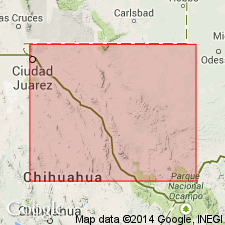
- Usage in publication:
-
- Powwow conglomerate member
- Modifications:
-
- Original reference
- Dominant lithology:
-
- Conglomerate
- Red beds
Summary:
Pg. 909, 911. Powwow conglomerate member of Hueco limestone restricted. Above the beds of Strawn age are limestones containing Canyon and Cisco fossils. CHAETETES is absent, and a zone of FUSULINELLA MEEKI occurs at base. Uppermost beds contain Cisco fusulinids (identifications of C.O. Dunbar). Near top is a member of conglomerate and red beds, which is folded with the rest of the Carboniferous. The red beds are well exposed 2 to 5 miles south of Hueco Canyon along main escarpment of Hueco Mountains. [Age is considered Permian(?).]
Named from Powwow Canyon [now spelled Pow Wow Canyon] 3.5 mi south of Hueco Canyon, which is followed by the new El Paso-Carlsbad highway [U.S. Route 62 / 180], Hueco Mountains, [Helms West Well and Phone Line Canyon 7.5-min quadrangles, El Paso and Hudspeth Cos.], western TX.
[Additional locality information from USGS GNIS database and USGS historical topographic map collection TopoView, accessed on September 10, 2023.]
Source: Modified from US geologic names lexicon (USGS Bull. 896, p. 1724).
For more information, please contact Nancy Stamm, Geologic Names Committee Secretary.
Asterisk (*) indicates published by U.S. Geological Survey authors.
"No current usage" (†) implies that a name has been abandoned or has fallen into disuse. Former usage and, if known, replacement name given in parentheses ( ).
Slash (/) indicates name conflicts with nomenclatural guidelines (CSN, 1933; ACSN, 1961, 1970; NACSN, 1983, 2005, 2021). May be explained within brackets ([ ]).

